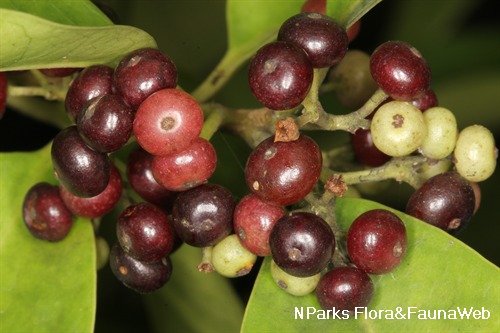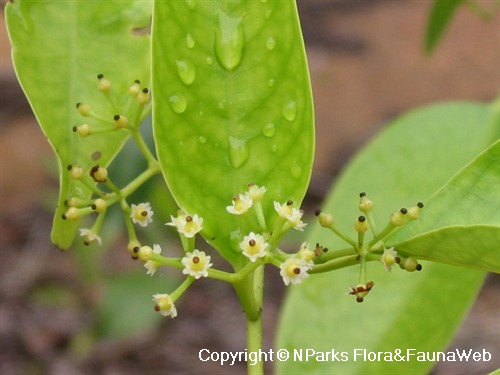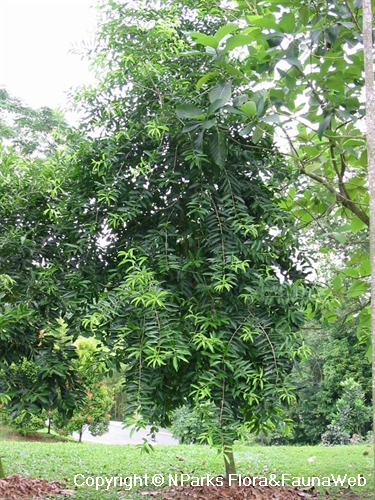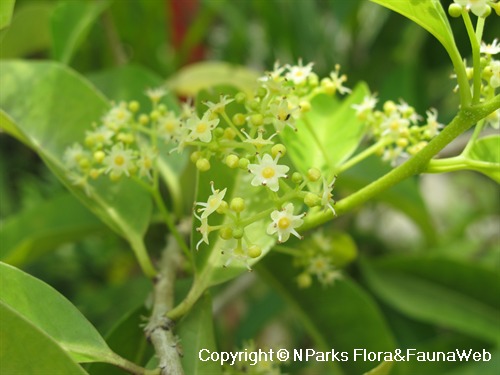
Back
Ilex cymosa Blume
| Family Name: | Aquifoliaceae |
| Common Name: | Marsh Holly, Mensirah, Mesirah, Timah-timah |
Name
Classifications and Characteristics
| Plant Division | Angiosperms (Flowering Seed Plants) (Dicotyledon) |
|---|---|
| Plant Growth Form | Tree |
| Lifespan (in Singapore) | Perennial |
| Mode of Nutrition | Autotrophic |
| Plant Shape | Rounded, Oval, Irregular |
| Maximum Height | 30 m |
Biogeography
| Native Distribution | Myanmar, Sumatra, Peninsular Malaysia, Singapore and Borneo. |
|---|---|
| Native Habitat | Terrestrial (Secondary Rainforest, Coastal Forest, Freshwater Swamp Forest, Riverine, Mountain), Shoreline (Mangrove Forest) |
| Preferred Climate Zone | Tropical |
| Local Conservation Status | Native to Singapore (Least Concern (LC)) |
Description and Ethnobotany
| Growth Form | It is an evergeen tree, up to 30 m tall. |
|---|---|
| Trunk | Bark becomes rougher and fissured as it grows older. |
| Foliage | Its alternate, stalked leaves have leaf blades that are oblong or elliptic, dark green to green above, pale green with a waxy bloom below, and 5-14 by 2.3-6.4 cm. |
| Flowers | Its small flowers are olive green, greenish-white, or white, and up to 3 mm wide. |
| Fruit | Its ovoid, fleshy fruits are berries that ripen from red to purple, then black, and are 3-4 by 3-5 mm, with eight to ten seeds inside. |
| Habitat | It grows in lowland coastal, peat swamp, riverine, mangrove and secondary forests. It also grows on hills up to 1,200 m altitude. |
| Associated Fauna | Food plant for caterpillars of the moth, the Blue-striped Nettle Grub (Parasa lepida) and caterpillars of the Studded Sergeant butterfly (Athyma asura), which is a rare species of butterfly in Singapore. Fruits are also eaten by birds. |
| Cultivation | A hardy tree that can be grown in most soil conditions, I. cymosa can be trained as a shrub around ponds, as well as a tree for gardens, parks and roadsides. |
| Etymology | Ilex, the genus epithet, is Latin for "holly", while the specific epithet, cymosa, is from Greek for "having flowers borne in a cyme", which describes the flowers of I. cymosa. |
| Ethnobotanical Uses | Medicinal: Leaves are used for treating sprains, while roots are used in the treatment of fever and ripening boils. Timber & Products: Wood from I. cymosa is used as firewood and to construct houses. |
Landscaping Features
| Landscaping | It is suitable for growing along roadsides, parks and gardens, and coastal areas for its fauna-attracting characteristics. |
|---|---|
| Desirable Plant Features | Ornamental Fruits, Ornamental Form |
| Landscape Uses | General, Suitable for Roadsides, Parks & Gardens, Small Gardens, Coastal, Pond / Lake / River |
Fauna, Pollination and Dispersal
| Fauna Pollination Dispersal Associated Fauna | Bird-Attracting (Fruits), Butterfly Host Plant (Leaves, Associated with: Athyma asura, Parasa lepida), Caterpillar Moth Food Plant (Associated with) |
|---|---|
| Pollination Method(s) | Biotic (Fauna) |
| Seed or Spore Dispersal | Biotic (Fauna) |
Plant Care and Propagation
| Light Preference | Full Sun, Semi-Shade |
|---|---|
| Water Preference | Moderate Water, Lots of Water |
| Plant Growth Rate | Moderate |
| Rootzone Tolerance | Moist Soils, Waterlogged Soils (Drains Site), Well-Drained Soils, Saline Soils / Salt Spray |
| Propagation Method | Seed |
Foliar
| Foliage Retention | Evergreen |
|---|---|
| Mature Foliage Colour(s) | Green |
| Mature Foliage Texture(s) | Smooth, Leathery |
| Foliar Type | Simple / Unifoliate |
| Foliar Arrangement Along Stem | Alternate |
| Foliar Attachment to Stem | Petiolate |
| Foliar Shape(s) | Non-Palm Foliage (Elliptical, Oblong) |
| Foliar Margin | Entire |
| Foliar Apex - Tip | Acuminate |
| Foliar Base | Rounded / Obtuse |
| Leaf Area Index (LAI) for Green Plot Ratio | 3.0 (Tree - Intermediate Canopy) |
| Typical Foliar Size | 5 cm to 10 cm |
Floral (Angiosperm)
| Flower & Plant Sexuality | Bisexual Flowers |
| Flower Colour(s) | White, Green - Light Green |
|---|---|
| Flower Grouping | Cluster / Inflorescence |
| Flower Location | Axillary |
| Flower Symmetry | Radial |
| Flowering Calendar | Jan, Feb, Mar |
Fruit, Seed and Spore
| Mature Fruit Colour(s) | Black, Purple, Red |
|---|---|
| Mature Fruit Texture(s) | Wrinkled, [Remarks] (Fruit surface always ribbed when dried.) |
| Fruit Classification | Simple Fruit |
| Fruit Type | |
| Seed Quantity Per Fruit | Moderate (6-10) |
References
| References | Tan, P.Y., R.T. Corlett and H.T.W. Tan (Editors). 2010. A Field Guide to the Native Garden @ HortPark: an Urban Oasis of the Native Flora and Fauna of Singapore. Singapore: Centre for Urban Greenery and Ecology (National Parks Board) and National University of Singapore. 124pp Tee, S.P., W.K. Yong, J.S.C. Ng and G.Z.M. Ong (Editors). 2009. Trees of Our Garden City (2nd Edition). Singapore: National Parks Board. 384pp |
|---|
Image Repository
Others
| Master ID | 1676 |
|---|---|
| Species ID | 2969 |
| Flora Disclaimer | The information in this website has been compiled from reliable sources, such as reference works on medicinal plants. It is not a substitute for medical advice or treatment and NParks does not purport to provide any medical advice. Readers should always consult his/her physician before using or consuming a plant for medicinal purposes. |



